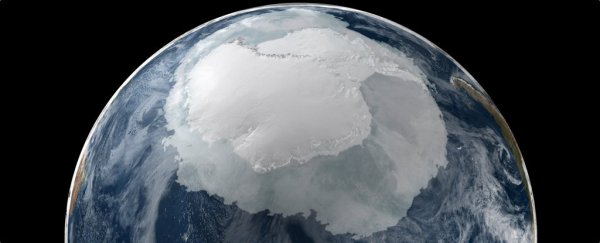Antarctic ice shelves are being destabilised by hidden, upside-down 'rivers' of warm water that course below the shelves and melt them from underneath, new research shows.
Scientists have known about these basal channels in ice shelves for a number of years now, but the circumstances behind their formation weren't well understood. Now, we've discovered more about the phenomenon, and scientists say it's something we need to take into account when modelling sea-level rise.
"Warm water circulation is attacking the undersides of these ice shelves at their most vulnerable points," says glaciologist Karen Alley from the College of Wooster in Ohio.
"These effects matter. But exactly how much, we don't yet know. We need to."
Ice shelves are an outwardly floating extension of the land ice that makes up continental ice sheets. In the case of Antarctica, about three-quarters of the continent is surrounded by floating ice shelves, which act like a natural barrier to help prevent glaciers on ice sheets from flowing into the ocean.
That natural barrier effect only works, though, if ice shelves themselves contain enough icy mass to buttress the seaward flow of grounded ice – and as we're starting to find, Antarctic barriers are weakening.
In 2016, a team fronted by Alley analysed satellite imagery of West Antarctic ice shelves and identified the upside-down 'rivers' of warm water eroding the shelves from underneath, rendering them more vulnerable to disintegration.
"Our observations show that basal channels are associated with the development of new zones of crevassing, suggesting that these channels may cause ice fracture," the researchers explained in their 2016 paper.
"We conclude that basal channels can form and grow quickly as a result of warm ocean water intrusion, and that they can structurally weaken ice shelves, potentially leading to rapid ice shelf loss in some areas."
In a new follow-up study, Alley and her team have taken another look at the basal channels to investigate what produces these upside-down rivers.
As it happens, the process first takes shape on the grounded mass of the Antarctic ice sheet itself, not on the floating ice shelf, the researchers say.
As ice flows out to the sea from the ice sheet on land, weak regions in fast-flowing ice called 'shear margins' can form at the edges of the mass.
In the new study, the researchers found basal channels were more likely to form along the margins of these weakened, fast-flowing ice stretches – a consequence of warm flows of buoyant water rising above cooler water below, and inducing melting in the most vulnerable sections in the ice shelves.
As this melting happens, a basal trough or channel is essentially carved into the underside of the fragile shear margin, laying bare the weakest of weak points, and producing ice shelf break-ups, as you can see in the video below:
"We're seeing a new process, where warm water cuts into the shelf from below," says one of the team, glaciologist Ted Scambos from the University of Colorado Boulder.
"Like scoring a plate of glass, the trough renders the shelf weak, and in a few decades, it's gone, freeing the ice sheet to ride out faster into the ocean."
While the researchers don't know to what extent these upside-down rivers might be hastening the processes of ice sheet collapse and sea-level rise more generally, they say it's important that we study the effects of basal channels and incorporate the phenomenon in future modelling of ice sheet changes.
"Critically, in our modern warming climate, warming of sub-ice shelf water may already be causing basal channel deepening in shear margins, which could strongly affect buttressing and may lead to enhanced calving and ice mass loss," the researchers explain in their paper.
Both Scambos and Alley are heading back to Antarctica this year to study the continent's ice mass dynamics further. Maybe then, we'll get a better idea of just what these upside-down rivers portend.
"This could matter a little, or it could matter a lot," Alley told National Geographic.
"But we know this makes it more likely that we lose ice shelves. These channels make the weak points weaker."
The findings are reported in Science Advances.
